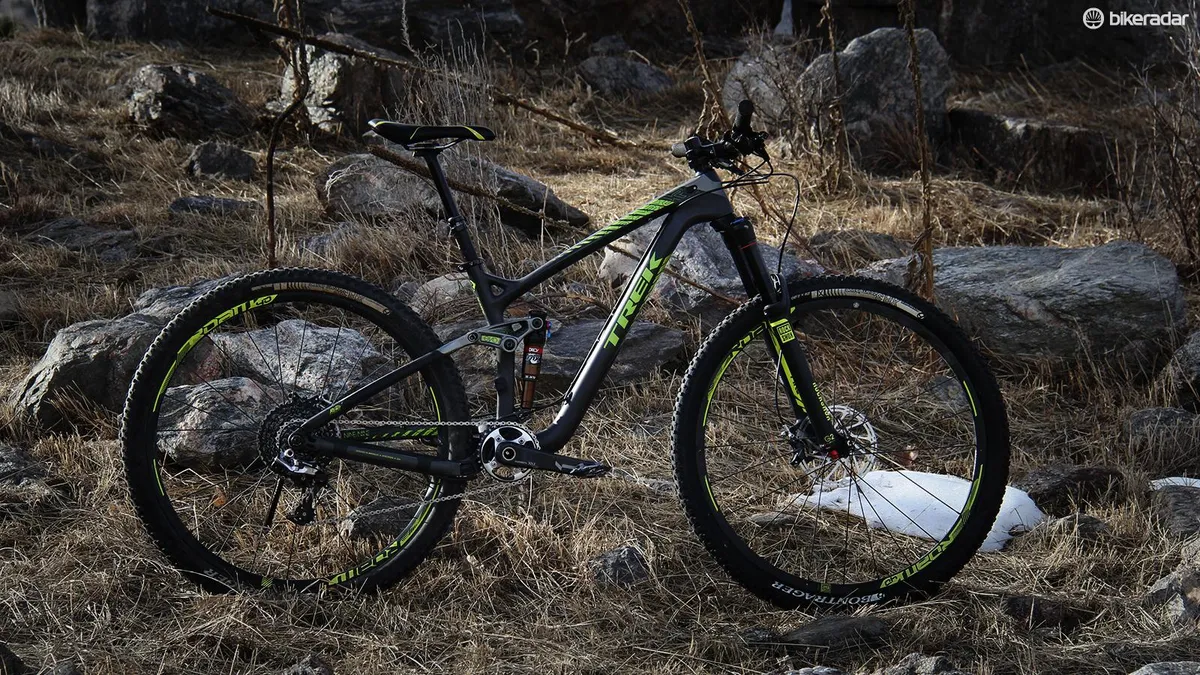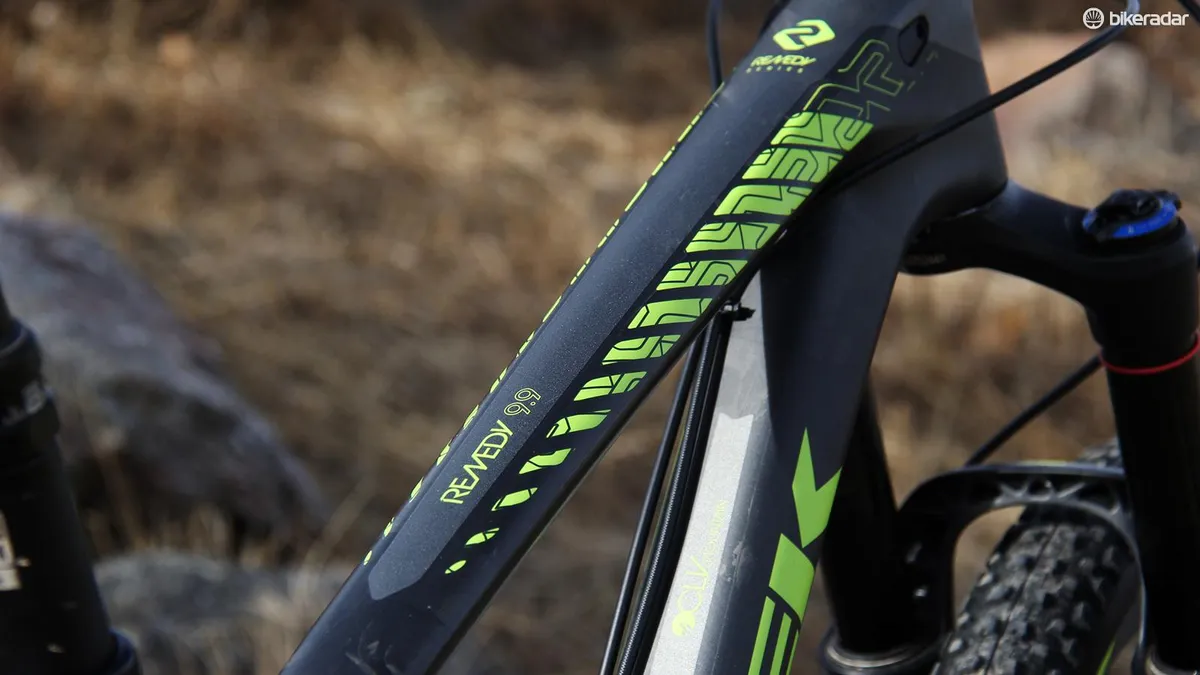I’ve put this review off several months out of a desire to keep the Remedy 9.9 29 in my clutches for as long as possible. Alas, all good things must come to an end, and so it is with a bit of regret that I box and ship the best bike I tested in 2015.
- Trek OCLV Carbon frame
- 140mm front and rear travel
- RockShox Pike fork
- Fox Float shock with RE:aktiv
- XX1 drivetrain
- XTR trail brakes
- Adjustable geometry
- 25.8lb/11.7kg without pedals (size 17.5)
Ride and handling: Damn good at everything

On paper, there’s very little about the Remedy’s geometry numbers that make it appear exceptional. The chainstay length is middle of the road by 29er standards, the bottom bracket is relatively high, even in the lower of the two geometry positions, and the head tube angle is par for the course for modern trail bikes.
But humdrum numbers don’t tell the whole story. After all, you’re not riding a head tube angle; you’re riding a bike. It’s the sum of the parts that make the Remedy 29 9.9 such a capable machine.
So capable, in fact, that it’s been the weapon of choice for two of Trek’s top enduro racers. Despite the fact the Remedy 29 platform comes up short on suspension travel when compared to most enduro race bikes. It has proven itself to be incredibly adept at outpacing longer travel rigs with smaller wheels.
Trek enduro racers Tracey Mosely and Justin Leov certainly weren’t held back by it. Mosely handily cinched the Enduro World Series crown, winning six of eight rounds along the way. Leov was on a similar track before sustaining a shoulder injury.
Related: Tracy Mosely and Justin Leov’s Remedy 29ers
I didn’t rack up any EWS wins simply by hopping aboard the Remedy, but I think I understand its appeal to these world-class athletes. As obvious as I hope it sounds to most readers, a significant portion of enduro racing is well, endurance. In races without chairlifts or shuttles, riders spend the majority of their time riding — generally uphill — to the next timed downhill stage. Having a lightweight machine that isn’t a burden on the climbs means you’re fresher, less fatigued and more focused for your race run. The Remedy 29 9.9’s big wheels and efficient suspension ease the pain of transition stages and make short work of rowdy descents. Off the racecourse, these are the traits I came to appreciate during long, technical trail rides in the Colorado Rockies.
I found the Remedy 9.9 29 to be a superb climber. The neutral geometry kept the front end from rising up and wheel flop was nearly non-existent. Trek’s ABP suspension design paired with the RE:aktiv shock provided traction without sacrificing pedaling efficiency. After some tinkering with the shock (more on that later), I generally left it in the ‘open’ position, although the middle, ‘trail’ mode was useful for scrambling up technical pitches; it provided enough suspension movement to keep the rear wheel tracking over obstacles without diving to far into the travel when mashing of the saddle.
The ‘climb’ mode was reserved for the smoothest ascents. The RE:activ valving was most noticeable in this position. It kept the suspension firmly seated at the sag point but, unlike a traditional lock-out, the shock opened up when the rear wheel encountered trail irregularities such as roots, rocks and any other obstacles that push the suspension past the sag point. It allowed just enough compression to maintain traction and prevent the rear end from bucking me out of the saddle or spinning out like a traditional lockout would have.
Related: Trek’s RE:aktiv suspension tech explained
Enough with the climbing talk. The Remedy 29 9.9 howls downhill. The 140mm RockShox Pike is a known entity, absorbing big and small impacts with poise and offering ample steering precision, even with big wheels.
My Colorado proving grounds are quite rocky, and strewn with large, square-edged boulders. It took the addition of a volume spacer to the rear shock to be as supportive as the Pike through successive impacts, but after that all was well. With the suspension tuned for my local terrain, the Remedy immediately shaved seconds off the descents on my test loops.
The neutral cockpit feel and stiff carbon frame allow the Remedy 29 9.9 to be equally happy to be straight-lined through boulder fields or to boost off alternative lines in search fun or style points.

No need to fuss with the adjustable geometry, just put it in low and go
While I found the Remedy’s handling to be great in all conditions, the adjustable geometry isn’t a feature that was particularly useful. After riding the Remedy 29 9.9 on a wide range of trails — rocky, rooty, loamy, smooth and buff, and over both steep and rolling terrain — I have yet to find a situation where the higher of the two geometry settings would have proven more advantageous. Moreover, the low position isn’t exceptionally low or slack: they’re just a good set of numbers for all-day trail riding.
Frame: top-end carbon and adjustable geometry

As the top bike in the Remedy 29 line, the 9.9 features an OCLV carbon front end, carbon seatstays and alloy chainstays. Trek claims the carbon frame sheds more than a pound over the alloy version.
To protect the carbon frame, Trek integrated a rubberized downtube protector as well as rubber guards on the side of the seatstays. It’s a nice touch that imparts a certain peace of mind when barreling headlong through rock gardens — you might not make it out unscathed, but it’s very likely the bike will be OK.
All models in the Remedy line use Trek’s Mino link, which allows riders to flip a chip to adjust their bike’s geometry between high and steep and low and slack. As previously mentioned, I rode the Remedy 29 9.9 in the high position just long enough to figure out that low and slack is where it’s at.
Flipping the Mino link from high to low dropped the bottom bracket from 14.1in/359mm to 13.7in/350mm. The head angle slacked from 68.2 to 67.5 degree. Chainstay length grew slightly from 17.4in/443mm to 17.5in/445mm.
Equipment: nearly there, but not quite perfect
As much as I loved the Remedy, there are things I would change about it.
For one, the stock Roam 40 wheelset is disappointingly narrow, with an internal width of just 21mm. To SRAM’s credit, the Roam 40 hoops proved quite durable and the freehub engagement is better than most budget wheelsets.
The stock Bontrager XR3 treads are fast rolling and lightweight, but hold the bike back on more demanding terrain. I quickly swapped them for Bontrager’s enduro-ready SE5 tires. Which, by the way, are outstanding in nearly all conditions.

The stock shock tune is a bit soft for aggressive trail riding. This is easily, ahem, remedied with a 7cc volume spacer
Another item that isn’t quite up to task is the RE:aktiv rear shock. Trek may have gone a bit too regressive with the shock tune. It doesn’t take much for the Remedy to work though all its travel. I was able to easily bottom out on square edge rocks despite running higher than suggested pressures. Thankfully, Trek offers an easy fix so rides can customize the suspension feel to suit their needs — the addition of a 7cc PUSH volume reducer to the RE:aktiv shock solved my woes.
Given my gripes with the wheelset, tires and suspension tune, it seems as if Trek didn’t fully grasp how capable of a bike it created. It’s doubtful the company will make the same mistake twice. In addition to a more aggressive component spec, I expect the next generation of the Remedy 29 line will have longer reach numbers and a slacker head angle to keep current with changing rider preferences.
In spite of these criticisms, the Remedy 29 remains the best bike I tested in 2015. It’s well-rounded without feeling watered down and quickly became the only bike I wanted to ride. As I’m packing it up to ship it home, I’m very tempted to order a frame and build it up to my liking.
Verdict
The Remedy 29 9.9 climbs with tenacity and descends with rapacity. If you’re looking for a true jack-of-all-trades machine for aggressive trail riding, this is it.










